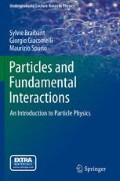Abstract
The first \({e}^{+}{e}^{-}\) colliders were completed in the 1960s at the Italian National Laboratories of Frascati with the small storage ring AdA followed by Adone (i.e., “big AdA”) at \(\sqrt{s} = 3\) GeV. A series of electron-positron colliders were successively built in the U.S., Europe, Japan, Russia and China. A major motivation for the construction of higher energy \({e}^{+}{e}^{-}\) colliders came from the discovery of the \(J/\psi \) particle at SLAC (Stanford, USA) in 1974. This meson is made of a \(q\overline{q}\) pair, where q is the fourth type of quark, that is, the charm. Previously, e + e − collisions provided the first experimental indication of the quark color quantum number. In 1977 the third lepton family (with the τ lepton) was discovered always at SLAC, immediately after the observation at Fermilab of the third family of quarks (with the bottom quark). In this chapter, we shall discuss this series of discoveries. Finally, high-precision measurements of the parameters of the electroweak theory and a thorough verification of the Standard Model have been performed since 1989 by the four LEP experiments at CERN (ALEPH, DELPHI, L3 and OPAL) and the SLD experiment at Stanford. These experiments, together with those at DESY and at the Fermilab \(\overline{p}p\) collider, represented a new era in terms of the size, complexity, accuracy and the number of physicists participating in a single experiment. A further increase is now observed for the LHC experiments.
Access this chapter
Tax calculation will be finalised at checkout
Purchases are for personal use only
Notes
- 1.
The composition in terms of the quark of these mesons is \({D}^{+} = c\overline{d},\;{D}^{-} = \overline{c}d\).
- 2.
The decay length L is given by \(L = \beta \gamma c\tau \) where \(\beta \gamma = p/m\), c is the speed of light and τ is the lifetime of the considered particle. With p ≃ 45 GeV, m τ = 1.7 GeV and ττ = 300 ×10− 15 s, one finds \(L = \frac{p} {m}c{\tau }_{\tau }\)= 2.5 mm.
- 3.
These events were first observed by the TASSO experiment at the PETRA accelerator at the DESY laboratory.
Author information
Authors and Affiliations
Corresponding author
Rights and permissions
Copyright information
© 2011 Springer Science+Business Media B.V.
About this chapter
Cite this chapter
Braibant, S., Giacomelli, G., Spurio, M. (2011). Discoveries in Electron-Positron Collisions. In: Particles and Fundamental Interactions. Undergraduate Lecture Notes in Physics. Springer, Dordrecht. https://doi.org/10.1007/978-94-007-2464-8_9
Download citation
DOI: https://doi.org/10.1007/978-94-007-2464-8_9
Published:
Publisher Name: Springer, Dordrecht
Print ISBN: 978-94-007-2463-1
Online ISBN: 978-94-007-2464-8
eBook Packages: Physics and AstronomyPhysics and Astronomy (R0)

